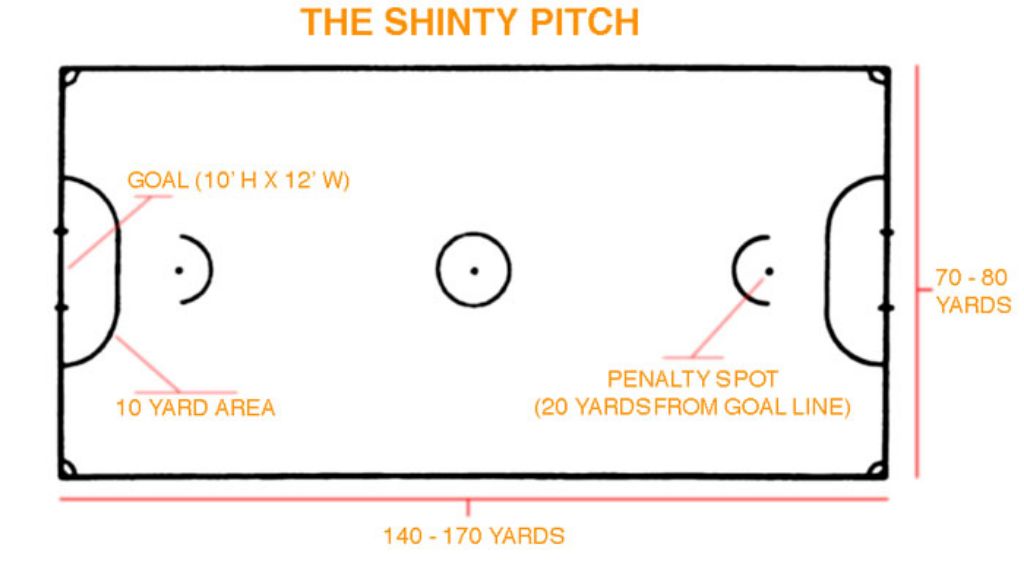The Rules of Shinty
This is a distillation of the current rules of shinty as played in Scotland and administered by the Camanachd Association. Our goal is to present an overview of the way shinty is played for the newcomer to the game. Full rules can be obtained from the Camanachd Association website here.

1. The Field of Play
A shinty pitch is rectangular, 140 to 170 yards in length and 70 to 80 yards in width, with markings to indicate the side and bye (or goal, or end) lines. There are also marks indicating a 10 Yard Area around the goals, the penalty and center spots (along with their associated arcs/circles of 5 yards radius), and corner arcs (of 2 yards radius). The goals themselves are 12 feet wide and 10 feet high and are affixed with netting to catch any successful goal shots. The Penalty Spots are centered on the goals and positioned 20 yards from the goal line.
2. Equipment
The shinty stick (called caman in Gaelic) is now usually made of laminated hickory or ash, and the head (which is wedge shaped, having a triangular cross section), must be able to pass through a ring two and a half inches in diameter. The ball has a seamed leather cover, with a permitted circumference between seven and a half and eight inches and weight between two and a half and three ounces. All-weather practice balls may have a rubberized coating and are not used in match play. Pictures of camans and balls can be found here.
Standard uniforms include matching jerseys, shorts, and socks, with goal keepers wearing contrasting jerseys to distinguish them from field players and referees. Standard protective equipment includes shin-guards and cups (for men), and some players also wear gloves and helmets (usually ice hockey or lacrosse helmets). Most players also wear cleated or studded shoes, though this is not required.
3. The Match
A match is played between two teams of twelve players each, one of whom is the goal-keeper. Two substitutes are allowed per team per match, and once a player is replaced they may not take any further part in the game. A match is divided into two 45 minute halves with a short intermission between. We usually play with fewer than 12 players a-side and alter the size of the field and length of halves accordingly.
Each team tries to score by directing the ball with the caman into the opposing team's goal. The ball may be struck on the ground or in the air, and players may use their body (excluding hands/arms and head) to stop the ball. Only the goalkeeper is allowed to touch the ball with their hand, and only using an open hand (slapping or stopping) within the 10 Yard Area. The ball may not be kicked, nor may one player strike another player in any way with his caman. However, a strike may be blocked or 'cleeked' within normal swinging distance by another player's stick.
The game is administered on the field by a referee whose job is to enforce and interpret the rules of play. The referee is assisted by two linesman (who watch the sidelines) and two goal judges (who watch the goals and 10 Yard Areas). The linesmen adjudicate side outs and indicate which team is entitled to the hit-in (shie). The goal judges indicate when a goal is scored and when an attacking player is off-sides.
The referee begins a match, and restarts after a goal and at half time, by throwing the ball up (approx. 12 feet or more) at the center of the field. The opposing center players, who hold their camans crossed above their heads ready to play the ball as it descends, position themselves for the toss-up so that the goals are on their left and right, the sidelines to their front and back. Play continues uninterrupted until a goal is scored, the ball leaves the field of play, or a foul is called by the referee.
4. Rules of play
When the ball passes over the bye-line, either in the air or on the ground, and was last played by an attacking player, it shall be hit back into play from a point within the 10 Yard Area by the defending team; this is called a bye-hit.
When the ball passes over the bye-line, either in the air or on the ground, having last been played by a defending player, a member of the attacking team shall take a corner-hit from the quarter circle at the nearest corner.
When the ball passes over the side-line, whether in the air or on the ground, it shall be hit into play by the team opposite to that who last touched it. This shall be done by means of an overhead hit, the player standing outside the side-line facing the field of play with both feet on the ground and in a position square to the side-line. The caman shall be withdrawn directly overhead and at the time of contact both the ball and the caman shall be directly overhead. If the player taking the hit misses the ball entirely the opposing team shall be awarded the hit-in.
A free-hit is awarded for any infringement of the rules, except by a defending player within the Ten Yard Area and shall be taken by the opposing side, from the place where the infraction occurred.
In all of these four cases the striker may not play the ball a second time until it has been touched/played by another player.
A goal is scored when the whole of the ball has passed over the goal-line and into the goal. You may not score directly from a free-hit; or by kicking the ball, carrying the ball, or propelling the ball with hand/arm/head. You may score directly from a corner hit, a hit-in (a shie), a penalty hit, or a bye-hit.
An attacking player is considered off-sides if they are within the 10 Yard Area before the ball enters the 10 Yard Area. Violation of this rule results in a free hit being given to the defending team to be taken from the point of the infraction.
A player may stop the ball with their feet if both heels are together at the moment of contact. If both feet are off the ground at the moment of contact, the referee shall be the sole judge of whether or not the player intentionally kicked the ball. A player may also stop the ball with other parts of their body excluding the hands, arms and head. Only the goalie may use the hands and arms to stop a ball.
It is considered illegal to: kick the ball; kick or attempt to kick an opponent; jump at an opponent; charge an opponent from behind; charge an opponent in a violent or dangerous manner; use the caman in a violent or dangerous manner; push an opponent; trip an opponent; strike or attempt to strike an opponent with the hand, arm or caman; strike or impede an opponent's caman (except to "block" or "cleek" a caman which is within striking distance of the ball); throw the caman; attempt to participate in the game without caman in hand; hold an opponent or an opponent's caman; obstruct an opponent (i.e. run between the opponent and the ball or interpose the body so as to form an obstacle to an opponent); handle the ball (i.e. carries, strikes or propels the ball with hand or arm); or head the ball.
Such violations shall be penalized with the awarding of a free hit to the opposing team, to be taken at the place where the foul was committed. Any such fouls committed by the attacking team within the 10 Yard Area shall result in the awarding of a free-hit to the defending team at the point of the infraction. If such a foul is committed by the defending team within the 10 Yard Area, a penalty hit shall be awarded to the attacking team to be taken from the penalty spot. The defending goal keeper must stand (without moving his feet) on his own goal line until the ball is struck, and no other players may be inside the penalty spot arc.
A player may be cautioned by the referee if they are guilty of: reckless or dangerous swinging of the caman; obstruction involving dangerous bodily contact; charging an opponent in a violent or dangerous manner; adopting a threatening or aggressive attitude; feigning injury; deliberately tripping an opponent; any kind of inflammatory action; using foul and abusive language; persistently violating the rules of play; arguing with the referee over a decision; or ungentlemanly conduct (i.e. shirt pulling, time wasting, encroaching, gesticulating in front of an opponent taking a free hit, entering or re-entering the field of play without first having received a signal from the referee to do so). Such violations can result in a yellow card (a warning) or a red card and ejection from the game.
